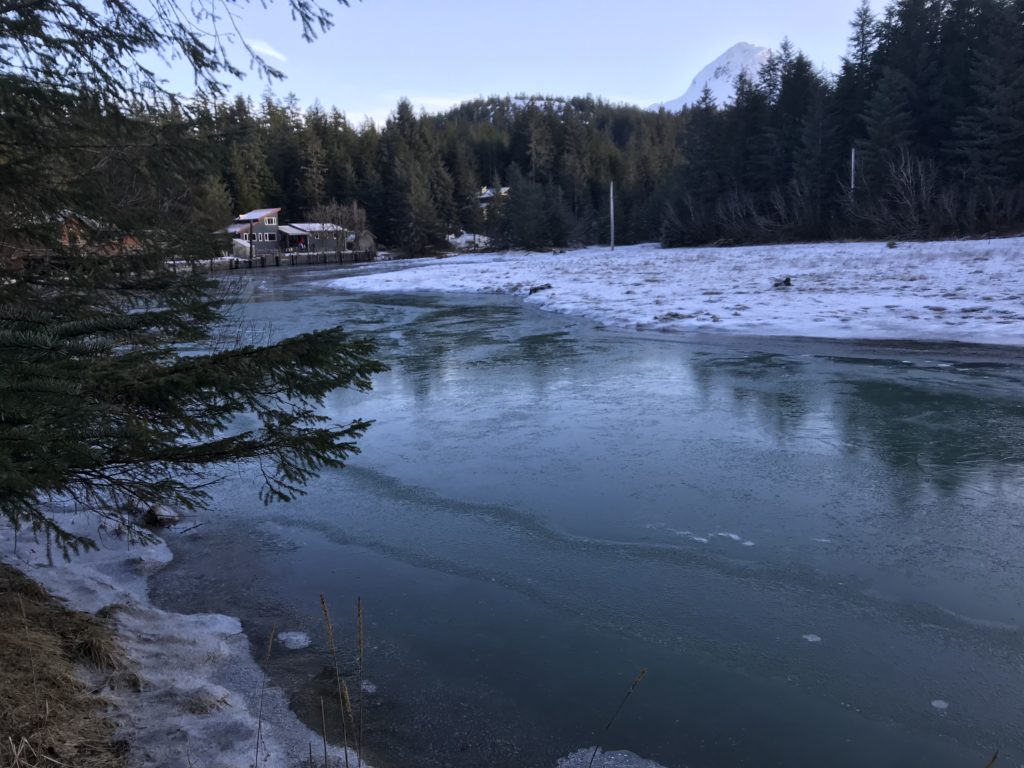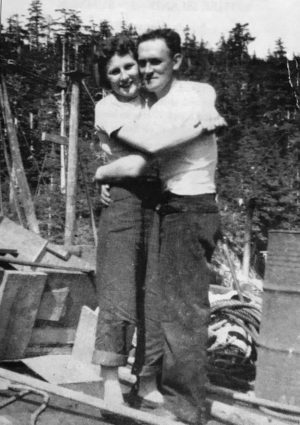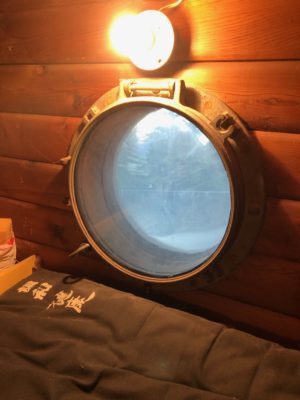
Finally, on Tuesday, March 1, 1949, weather abated and the stranded trio from the North Cloud was rescued.
It seemed almost anti-climactic, after eight days of drama.
“TRIO RESCUED FROM GRASS ISLAND BAR,” read the headlines of the March 2, 1949 edition of The Cordova Times.
“There was a happy reunion in Cordova last night at 10 o’clock as Martin Anderson’s fishing boat Lady Jane tied up in the small boat harbor and Mr. and Mrs. Howard and their son-in-law Robert Zentmire disembarked.”
There to meet them were members of the family that had come over from Seward to follow the rescue efforts.
“The trio was taken off the bar, where they had been camping in a makeshift hut, at 8:30 yesterday morning when four members of the Lady Jane crew, in a whaleboat manned by crewman from the Coast Guard Cutter Cedar, was successful in cutting through surf and ice pack to get to the beach — a successful landing after seven days of patient and difficult trials.
“The Cedar accompanied the Lady Jane back to Cordova during the 12-hour run from the flats yesterday.
“Camping on the windswept bar was monotonous and miserable, Howard said, but they did not suffer. The quarters were cramped, he said, but they had plenty of food and kept the place warm with a small Coleman stove. The most disagreeable part of the ordeal, Howard said, was winds which swept off the Copper River Delta. These often attained a velocity of 60 miles per hour and they were ‘chilly.’ Sleet and rain would freeze almost instantly.
“Mr. Howard paid high tribute to Lady Jane skipper Martin Anderson and his picked crew — Richard Davis, Lou McFerren, Jack Dinneen, and Nick Olson — for their patient work which at times reached dangerous proportion. He also praised the splendid cooperative efforts given by the Cedar and its crew who he said ‘worked hand in hand at every opportunity to give the Lady Jane aid. They are all a fine bunch of men and we deeply appreciate what they have done.’”
The North Cloud was never salvaged, and ironically, almost exactly two years later, on another rescue mission, the Lady Jane would meet a similar unfortunate fate.
On Jan. 11, 1951, Anderson was on his way to Valdez to pick up the Cordova High basketball team, which had been stranded there because of poor flying weather.
While heading up Valdez Arm in lowering visibility, darkness, and a shift in tides, the 73-footer ran into Potato Point, a prominent outcropping just outside the entrance to the Valdez Narrows.
After backing off the rocks, it was evident the Lady Jane was badly holed and filling rapidly. It was low tide, so Capt. Anderson picked a stretch of smooth beach and ran the boat on it. Help was summoned by radio and a small boat from Valdez picked up Anderson and his crew, Ed Hanson and Terry Kavisto.
Salvage operations were repeatedly delayed due to weather, and not until April 4, 1951, was the boat pulled off the beach by the Kodiak Salvor, under the direction of Bob Logan, a local marine surveyor.
Incredibly, after three months underwater, the engines of the durable Lady Jane brought her home under her own power, in what was described by Cordova Times editor Everett Pettijohn as “a triumphant return.”
But for reasons unknown, Martin Anderson opted not to repair it.

“It was an older boat, but not in that bad of shape,” said his nephew Tom Anderson, of Cordova, on Feb. 11, 2021.
Perhaps cost was a factor. At the time of its sinking, Martin Anderson had estimated the costs for repairs to be $10,000. In today’s dollars, that would be almost $110,000.
Instead, it was beached in Eccles Lagoon, located around the corner from today’s sewer treatment plant, about a mile out Whitshed Road.
The lagoon was at one time a major winter storage place for barges, floating canneries, and other vessels prior to the earthquake.
Following the earthquake uplift, a number of craft were stranded there, and the lagoon became a popular place for home development.
Cordovan Paul Swartzbart ended up building a home on a knoll overlooking the remains of the abandoned Lady Jane, and recounted teaming up with other residents of the area to clean up the wreckage.
After trying to burn up as much as possible and ruining countless chains on chainsaws in the process, they hired Wilson Construction to bring in an excavator and bury what was left.
All that remains today of the legendary ship is an open stretch of tide-water gravel.
Back in the ‘50s, Eccles Lagoon was a popular place for Cordova youngsters to play. It could be accessed by an elevated wooden walkway that began right on the edge of Eccles Creek, and its variety of abandoned ships was quite an attraction.
Tom Simpler and Randy Bruce were one such pair of lads. They decided to salvage one of the abandoned Lady Jane’s trademark pilot house portholes, and after carrying it all the way to town, used it in a “fort” built behind Simpler’s house near the Mt. Eccles playground.
Eventually the inch-thick glass in the porthole was chipped and cracked from rocks being thrown at it by kids in the playground. Simpler decided to have the glass replaced and took it back to be a part of a home he was building in Kodiak, where he taught mathematics for years and still resides.

Anderson, meanwhile, continued as a well-regarded seaman and talented boat builder, creating a line of shallow-draft flat-bottomed 34-foot vessels designed for the Copper River flats. The first was named the Linda Marnell after his daughters; then came the Vecci, the Kathleen L, and the Krissel.
In late 1959, Tom and his dad Charlie helped Martin build the Vecci for the Simplers. It is the only surviving member of Martin’s fleet and can be seen moored at the end of B Float in the North Cordova boat harbor.
Martin Anderson was born in Ellamar, Alaska on Sept. 8, 1916, and passed away here in Cordova on May 5, 1969.
He is buried in the Old Cordova cemetery.
His famous Lady Jane is buried at Eccles Lagoon.
And the porthole through which he peered during the dramatic rescue of the North Cloud in February 1949, as well as during the Lady Jane’s sinking in Valdez Arm two years later, is now part of Tom and Arlene Simpler’s lovely home in Kodiak.





